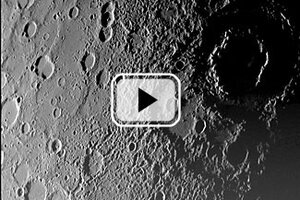Messenger images show hidden face of Mercury
In the first flyby of Mercury in 33 years, the NASA spacecraft captured thrilling new details about the little-known planet.

This photo shows a view of Mercury's rugged, cratered landscape, taken by NASA's Messenger spacecraft on Monday, Jan. 14, 2008.
NASA
Mercury, one of the solar system's most enigmatic planets, is showing a new face these days. For scientists poring over the first portraits from National Aeronautics and Space Administration's Messenger spacecraft, the views are breathtaking.
For the first time in 30 years, scientists are seeing the full expanse of a vast impact crater, which has a bizarre spiderlike formation at its center; each "leg" stretches more than 50 miles. The spacecraft has also provided the first detailed measurements of the planet's tenuous atmosphere and its interaction with the solar wind.
These are among the initial observations scientists unveiled at a briefing Wednesday in Washington on the Messenger orbiter's first Mercury flyby on Jan. 14. The flyby was the first of two it will perform this year before it settles into orbit around the planet in 2011.
"This first encounter was just amazing," says James Head III, a planetary scientist at Brown University and a member of the mission's science team. Dr. Head prepared an initial set of maps for the mission showing unknown areas – the previous mission by Mariner 10 imaged 45 percent of the planet's surface. "Now, a significant part of that is filled in."
And while Messenger's images so far don't match the level of detail they'll reach once the craft orbits the planet, they're "revealing the totally interesting parts of the unseen side."
NASA launched Messenger in August 2004. It's the first trip to the first rock from the sun since Mariner 10 conducted three flybys in 1974 and 1975. As the smallest of the solar system's eight planets, Mercury holds a key place in the evolutionary spectrum for planets. While it looks like the cratered moon from a distance, up close it displays a range of features that hint at a far different birth and geological history. Yet its proximity to the sun makes it difficult to study with optical telescopes.
Approaching Mercury from its nightside, Messenger's flybys are gathering information on the magnetic tail that stretches behind the planet and the mix of charged particles that get swept along with it, says Sean Solomon, the mission's lead scientist.
As it approached the planet, Messenger compared concentrations of hydrogen and sodium ions and found large differences in their abundance between northern and southern hemispheres. The hydrogen comes from the solar wind – a stream of charged particles the sun emits – while the sodium either comes from Mercury's original material or perhaps from meteoroids. What scientists see is likely the result of the solar wind hitting sodium and ionizing some of it. Once liberated, the sodium ions get swept into the planet's magnetic field and carried down the field's tail, stretching away from the night side of the planet. "This speaks to very dynamic processes going on over very short time scales" in Mercury's environment, says Dr. Solomon, director of the department of terrestrial magnetism at the Carnegie Institution of Washington.
Perhaps the most captivating images so far involve the Caloris Basin, an impact crater some 930 miles across. Mariner 10 captured only a third of it; now, scientists are seeing the whole thing. Because its rim hosts rocks kicked up from inside the planet, the crater is a window on the planet's interior, says Head.
The spiderlike feature at the basin's center is the first of many puzzles Messenger is likely to pose. Head speculates that the legs could represent post-impact underground cracks that became pathways for magma to well up and form dikes. Or they could be residual surface cracks that appeared as the basin's center rebounded from the impact.
These new questions are just as intriguing as the longstanding ones Mariner 10 posed, he says. More important than what these first close-ups may say about the planet, however, is the shape they'll give the science agenda once Messenger begins orbiting Mercury.
The mission has a special meaning for Robert Strom, professor emeritus at the University of Arizona's Lunar and Planetary Laboratory and the only scientist on the team who also worked on the Mariner 10 mission.
"I couldn't sleep on the eve of the encounter," he recalled during Wednesday's briefing. "I've waited 30 years for this. Every part of the planet seen or unseen is new. This is a whole new planet."
